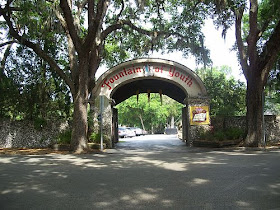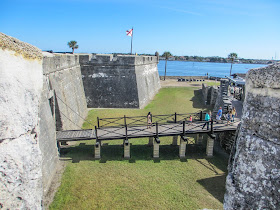A convergence of events got me thinking about St. Augustine, Florida (which I visited in January 2013) recently: We visited the Library of Congress in Washington, D.C. and saw a special exhibit that included the earliest map of St. Augustine, the oldest continually occupied European settlement in the U.S.; and we visited San Juan, Puerto Rico and the Cathedral of San Juan Bautista which contains the remains of Juan Ponce de Leon, the former governor of Puerto Rico, but also the person who named Florida and may have been the first European to visit the St. Augustine area.
Ponce de Leon received a contract from Ferdinand II of Aragon (the same Ferdinand that was married to Isabella and sent Columbus to the New World) to try to discover new lands outside of those discovered by Columbus. In 1513, with three ships and two hundred men, all at his own expense, he sailed northwest. On April 2nd he found what he believed was an island and called it La Florida because it was Easter season and so lush and beautiful (the Spanish called Easter "Pascua Florida," the Festival of Flowers). The exact location is disputed, but some believe it was what is now the west side of Matanzas Bay in St. Augustine. They remained about five days, then headed south. Later legend claims Ponce de Leon was in search of the fountain of youth, and, of course, there is a private park in St. Augustine which includes a fresh water spring which is claimed to be the fountain discovered by Ponce de Leon.
 |
| Fountain of Youth in St. Augustine - picture from Wikipedia. |
52 years later, on September 8, 1565, St. Augustine was founded by Pedro Menenez de Aviles, who became Florida's first governor. He had come from Cadiz, Spain and called the place "San Agustin" because they'd first sighted land 11 days earlier on the feast day of St. Augustine. The first settlement was located near Matanzas Bay and the above spring, a spot that offered good defensive positions. The fleet chaplain, Father Francisco Lopez de Mendoza Grajales, created a rustic altar and "Mass was said to hallow the land and draw down the blessing of heaven before the first step was taken to rear a human habitation." This was the first mass celebrated in the U.S. and the spot has been called "America's most sacred acre." Father Lopez put the following in his diary: "On Saturday the 8th, the General [Menendez] landed with many banners spread, to the sounds of trumpets and salutes of artillery. As I had gone ashore the evening before, I took a Cross and went to meet him singing the hymn,Te Deum Laudamus. The General, followed by all who accompanied him, marched up to the Cross, knelt and kissed it. A large number of Indians watched these proceedings and imitated all they saw done." Following the mass a feast was held. Father Lopez was the first pastor of the parish of St. Augustine.
 |
| A re-creation of the rustic altar. |
In 1958, a statue of Father Lopez was erected near the site of the mass. It was created by Ivan Mestrovic, a sculptor we first learned about in the Balkins and have fallen in love with his work. The statue portrays Father Lopez in his priestly vestments preaching the gospel. In 1966, in celebration of the 400th anniversary of the founding of St. Augustine, the world tallest cross, 208 feet, was erected near the landing and settlement spot.
 |
| The cross through the trees near the altar. |
 |
| The Mestrovic sculpture of Father Lopez. |
The St. Augustine map I saw in the Library of Congress was depicting an attack by Sir Francis Drake of Britain on St. Augustine in 1586. The map depicts Drake capturing and burning the city and fort of St. Augustine. Made by Baptista Boazio in 1589, it is the earliest engraving of any city or territory that is now part of the United States.
 |
| The site of the first mass and cross would be on the land opposite the opening in the land mass, and just a little to the left. |
A Spanish Catholic Mission, the Nombre De Dios, was founded in this same area a year later, in 1587. First manned by Jesuits, then later Franciscans, it served nearby villages of Indians. It was named after a local village of Mocama Indians by that name in which the chief and her daughter were Catholic converts.
By 1615 a chapel was erected to house a statue of the Virgin Mary nursing the baby Jesus. It was the first Marian Shrine in the U.S. and is known as the Shrine of Our Lady of Leche. The original chapel was destroyed by the British in 1728 during the British siege of St. Augustine. It was rebuilt in 1875 and later damaged by a hurricane. The current chapel was built in 1914 and is a replica of the prior buildings.
 |
| Shrine of Our Lady of La Leche. |
Castillo de San Marcos, the oldest masonry fort in the U.S., was built in Matanzas Bay, not too far from the Nombre de Dios Mission. Construction started in 1672, after a raid by the English privateer, Robert Searles, in 1668, and it was completed in 1695. Possession has changed hands six times in a history I don't want to go into.
 |
| Castillo San Marcos in the distance. |
 |
| The Castillo is located to the right of the area where the ships are burning a fort and the town on the 1589 map. |
I previously did a post on the Cathedral Basilica of St. Augustine which was finished in 1797 and is a wonderfully distinctive church.




The picture of the huge cross and Mestrovic sculpture together somehow remind me of the Christ the Redeemer statue in Rio. I had no idea there were so much "ancient" history artifacts in St. Augustine. Great historical review.
ReplyDelete